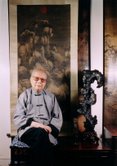 I began collecting rocks in my twenties, more than sixty years ago. Ever since, my interest has never diminished. Western painters use human bodies as models while we landscape painters prefer rocks. Human beings, despite differences in appearance, height, proportion and weight, are on the whole not much different from one another. Rocks come from nature, and they are God’s masterpieces, widely different in shape, material, color, texture, and, more importantly, in artistic conception and charm. To depict a rock in a landscape is to paint its bones and frame. A good landscape painter has a profound understanding of the shape and surface texture of a rock.
I began collecting rocks in my twenties, more than sixty years ago. Ever since, my interest has never diminished. Western painters use human bodies as models while we landscape painters prefer rocks. Human beings, despite differences in appearance, height, proportion and weight, are on the whole not much different from one another. Rocks come from nature, and they are God’s masterpieces, widely different in shape, material, color, texture, and, more importantly, in artistic conception and charm. To depict a rock in a landscape is to paint its bones and frame. A good landscape painter has a profound understanding of the shape and surface texture of a rock.
Chinese painting, both in past and present, focuses on texture and brushwork. Truthful depiction of landscape was valued in ancient Chinese painting from the Five dynasties (907-960) until the Yuan dynasty (1279-1368) when Ni Zan shifted the focus to use of the brush.
Rocks, like paintings, are not restricted by years or given cultures, nor are they confined to the West or the East. They can serve as a bridge that transcends time, space, and culture.
In the early years of my life, I loved the truthful representation of mountains and rivers in a traditional way. later, I came to love abstract landscape paintings that stress the use of ink and brushwork. This change was brought about by revelations from ‘God’. A good abstract landscape should be doubly abstract — offering an image that goes beyond the image of the landscape while expressing the painter’s response to real mountains and hills as he conceives them, a canny inspiration that defies description. It is just like an opera performance in which not only a plot unfolds, but also the music, the sound beyond the words sung by the performers, as well as their feelings based on their interpretation of the characters they portray.
When I collect rocks, I am not concerned with their date or place of origin. My interest lies solely in their beauty, their abstract beauty. The beauty of a rock goes beyond any superficial explanation. I view them as pictures, cubist and abstract pictures. They are God’s creations bestowed upon us.
C. C. Wang is a renowned Chinese landscape painter and an outstanding contemporary gongshi collector.
This Essay was written for Kemin Hu’s book The Spirit of Gongshi: Chinese Scholar’s Rocks